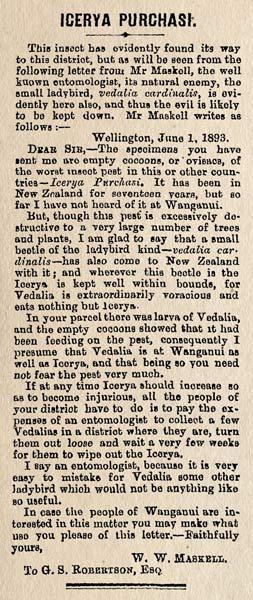
In the late 19th century the cottony cushion scale (Icerya purchasi Maskell) was widespread on orange and lemon trees, where it decimated fruit production. It was also found on gorse, broom, rose bushes, pines, cypresses and grass. The pest was later controlled by a self-introduced ladybird from Australia (Rodalia cardinalis Mulsant). This promoted public confidence in biological control, which helped to reduce the use of toxic chemicals to control insect pests. In this letter in the Wanganui Herald of 22 June 1893, entomologist W. W. Maskell comments on the presence of Icerya purchasi, and also of Vedalia cardinalis (now called Rodalia cardinalis) at Whanganui.
Te whakamahi i tēnei tūemi
National Library of New Zealand, Papers Past
Reference:
Wanganui Herald, 22 June 1893, p. 2
Permission of the National Library of New Zealand, Te Puna Mātauranga o Aotearoa, must be obtained before any re-use of this image.







Tāpiritia te tākupu hou